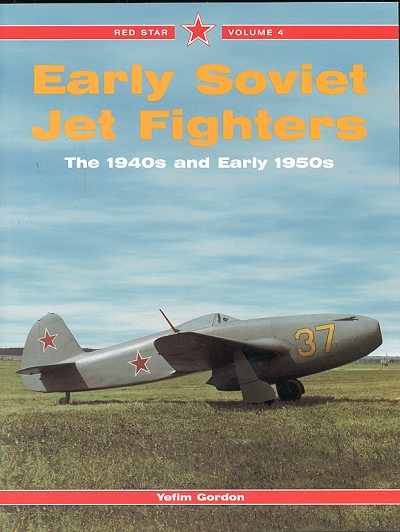 I've always been fascinated by the early uses of
technology. This particular book is by Soviet aviation expert Yefin Gordon and
covers the early attempts at building jet powered aircraft following the Second
World War. Despite the war being over, the Soviets drove their designers and
factory workers as if it was still going strong in an attempt to catch up with
the Allied powers. Thanks in many ways to the stupidity of the British
government by selling top of the line turbojet engines to the Soviets, by 1950
they had a world class fighter in the guise of the Mig-15.
I've always been fascinated by the early uses of
technology. This particular book is by Soviet aviation expert Yefin Gordon and
covers the early attempts at building jet powered aircraft following the Second
World War. Despite the war being over, the Soviets drove their designers and
factory workers as if it was still going strong in an attempt to catch up with
the Allied powers. Thanks in many ways to the stupidity of the British
government by selling top of the line turbojet engines to the Soviets, by 1950
they had a world class fighter in the guise of the Mig-15.
However, this book doesn't go that far and having the 'Early
1950's' in the title is somewhat misleading as it basically stops around 1950.
All of the aircraft in this book have one thing in common and that is straight
wings. None of them are swept winged so don't go looking for any of the swept
wing MiGs, Yaks, or Lavochkins in this volume.
The cover shows the first of the Soviet fighters, the Yak-15 or
Yak-Jumo as it was basically a Yak-3 mated to a Russian-built Jumo OO4B. Like
other early jets, it was powered by Russian copies of German Jumo and BMW
turbo-jet engines. Even later jets were powered by copies of British engines. Of
course, in the US, the situation was basically the same as US engine makers were
unable to equal the power or reliability of British-designed engines for some
time.
The book covers aircraft designed by all the major players in the
design of postwar jet aircraft and the various sections are really divided by
designer. Of course the head of this was Yakovlev. An important man in the
Soviet hierarchy, he used that position and influence to ensure that his designs
were always started first. It was only due to the brilliance of the MiG-15 that
his Yak fighters were turned into little more than stop-gap aircraft or jet
transition trainers. Yak aircraft include the Yak-15, Yak-17,
Yak-19, Yak-23, and Yak-25. Yakovlev's aircraft take up a considerable
percentage of the book.
The only MiG aircraft covered is the MiG-9, yet it was probably
the most successful of the very early Soviet jets. Like the other sections, the
MiG section is full of the problems of producing aircraft in the Soviet Union at
that time. Schedules were very tight and it was expected that aircraft go from
drawing board to squadron use in less than a year! It also has a very large
number of photographs that are crisp and clear. Most of them have not been seen
before by this reviewer so were of a great deal of interest.
Minor players on this stage were Lavochkin with his 'aircraft 150'
and 'aircraft 153' designs. Sukhoi actually got a designation for his Su-9 and
Su-11, but they were also naught but prototypes. The final type was from
Alekseyev who produced several twin engine heavy fighter prototypes, the
I-211/215 series that was quite interesting looking but not a successful
design.
The 144 page, soft-bound book not only includes an intro section
which mostly delves into experimental WWII attempts at rocket assisted aircraft,
but also has several pages of color profiles of the various types in the book.
This is accompanied by a number of color photos of the few surviving types
Personally, I found the entire book to be a fascinating read, as
much for all the political wrangling as for the actual design, testing and
eventual squadron use of the aircraft involved. If early jet design in general
and Soviet aviation in particular are something that interests you, I can highly
recommend this book to you.
Review book courtesy of  , where you can order
your copy of this and many other superb aviation and modeling books.
, where you can order
your copy of this and many other superb aviation and modeling books.
If you would like your product reviewed fairly and quickly by a
site that has well over 150,000 visitors a month, please contact me or see other details in the Note to Contributors.
 I've always been fascinated by the early uses of
technology. This particular book is by Soviet aviation expert Yefin Gordon and
covers the early attempts at building jet powered aircraft following the Second
World War. Despite the war being over, the Soviets drove their designers and
factory workers as if it was still going strong in an attempt to catch up with
the Allied powers. Thanks in many ways to the stupidity of the British
government by selling top of the line turbojet engines to the Soviets, by 1950
they had a world class fighter in the guise of the Mig-15.
I've always been fascinated by the early uses of
technology. This particular book is by Soviet aviation expert Yefin Gordon and
covers the early attempts at building jet powered aircraft following the Second
World War. Despite the war being over, the Soviets drove their designers and
factory workers as if it was still going strong in an attempt to catch up with
the Allied powers. Thanks in many ways to the stupidity of the British
government by selling top of the line turbojet engines to the Soviets, by 1950
they had a world class fighter in the guise of the Mig-15.